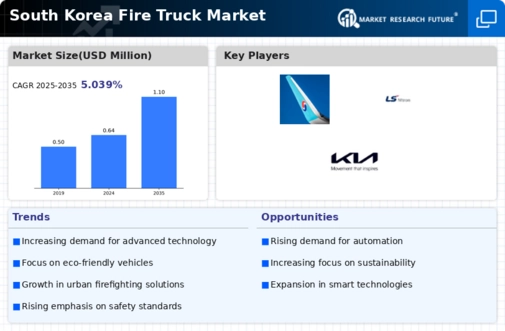Rising Urban Population
The fire truck market is significantly influenced by the rising urban population in South Korea, which has been growing steadily. As urban areas expand, the demand for efficient emergency response systems becomes increasingly critical. The urban population is projected to reach approximately 83% by 2025, necessitating a robust fire service infrastructure. This demographic shift compels local governments to invest in modern fire trucks that can navigate densely populated areas effectively. Additionally, urbanization often leads to increased fire hazards, further amplifying the need for advanced firefighting equipment. Consequently, the fire truck market is likely to see a surge in demand as municipalities strive to ensure adequate fire protection and response capabilities in urban settings.
Increasing Government Investment
The fire truck market in South Korea is experiencing a notable increase in government investment aimed at enhancing public safety infrastructure. Recent allocations have focused on modernizing fire services, with budgets rising by approximately 15% annually. This financial commitment is likely to facilitate the procurement of advanced fire trucks equipped with cutting-edge technology. Furthermore, the government's emphasis on disaster preparedness and response capabilities is expected to drive demand for specialized vehicles. As municipalities seek to upgrade their fleets, the fire truck market is poised for growth, reflecting a broader trend of prioritizing emergency services. This investment not only bolsters the operational efficiency of fire departments but also ensures that they are better equipped to handle emergencies, thereby enhancing community safety and resilience.
Increased Awareness of Fire Safety
There is a growing awareness of fire safety among the South Korean populace, which is significantly impacting the fire truck market. Public campaigns and educational programs have heightened the understanding of fire risks and the importance of effective firefighting services. This increased awareness is likely to lead to greater demand for fire trucks, as communities recognize the need for well-equipped fire departments. Local governments are responding by allocating more resources to fire services, with an estimated increase of 20% in funding for fire safety initiatives. As a result, the fire truck market is expected to expand, driven by the need for enhanced fire protection measures and community engagement in safety practices.
Environmental Regulations and Standards
Stringent environmental regulations and standards in South Korea also shape the fire truck market. As the government enforces policies aimed at reducing emissions and promoting sustainability, fire departments are compelled to transition to eco-friendly vehicles. This shift is likely to drive demand for fire trucks that utilize alternative fuels or hybrid technologies. The market is expected to see a growth rate of around 12% as manufacturers innovate to meet these regulatory requirements. Compliance with environmental standards not only enhances the public image of fire services but also aligns with broader national goals of sustainability. Consequently, the fire truck market is adapting to these changes, fostering the development of greener firefighting solutions.
Technological Integration in Fire Services
The integration of advanced technologies into fire services is a key driver of the fire truck market in South Korea. Innovations such as IoT-enabled devices, drones, and real-time data analytics are transforming firefighting operations. Fire trucks are increasingly being equipped with smart technologies that enhance situational awareness and operational efficiency. For instance, the adoption of GPS tracking and automated dispatch systems can reduce response times significantly. The market for fire trucks was projected to grow by approximately 10% annually as fire departments sought to leverage these technologies. This trend indicates a shift towards more sophisticated firefighting solutions, which not only improve response capabilities but also optimize resource allocation within fire services.

















Leave a Comment